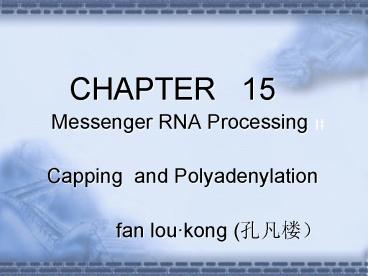Messenger RNA Processing - PowerPoint PPT Presentation
1 / 26
Title:
Messenger RNA Processing
Description:
CHAPTER 15. Messenger RNA Processing ?. Capping and Polyadenylation. fan lou kong (???) ... Functions of Ploy(A) 1.Protection of mRNA. The Figure 15.10 examined it. ... – PowerPoint PPT presentation
Number of Views:1550
Avg rating:3.0/5.0
Title: Messenger RNA Processing
1
- CHAPTER 15
- Messenger RNA Processing ?
- Capping and Polyadenylation
- fan loukong (???)
2
- This chapter includes 3 parts
- 1.Capping
- 2.Polyadenylation
- 3.Coordination of mRNA Processing Events
3
Capping
- 1.Cap Structure
- 2.Cap Synthesis
- 3.Functions of Caps
4
Cap Structure
- 1.The first caps to be characterized came from
viral RNAs.Bernard Moss and his colleagues
produced vaccinia virus mRNA labeled with 32p
in vivtro and used DEAE-cellulose chromatography
to isolated the Caps. - 2.The researchers found they could label the Cap
with ß,?-32pATP(but not with ?-32pATP).
5
- So they put forward the Cap was at the
5-terminus of the RNA. Because the ß-phosphate
of a nucleoside triphosphate remains only in the
first nucleotide in an RNA. - They also think there must be some substance (x)
to protect or block the ß-phosphate, because the
alkaline phosphatase cant remove it. - What is x?
6
Block agent Xp X
- The researchers use phosphodiesterase to remove
block agent to get Xp,and use phosphomonoesterase
to get X. - Then they subject this digest to paper
electrophoresis,followed by paper chromatography.
- The figure 15.2 shows the X is m7G
7
(No Transcript)
8
- Another product of phosphadiesterase cleavage of
the cap was pAm(2-o-methyl-AMP),thus m7G is
linked to pAm in the cap. - But whats the nature of the linkage?
- The following three considerations tell us it is
a triphosphate and the linkage is very likely to
be 5to 5 1.the ?-phosphate,but not the
ß-or?-phosphate of GTPwas remained in the cap. - 2. the ß-and ? -phosphates of ATP are remained in
the cap . - 3. Both ATP and GTP have their phosphates in the
5-position.
9
Cap Synthesis
- The researchers studied capping of model
substrates in vitro, they used cores from
vaccinia virus and reovirus ,respectively,to
provide the capping enzymes. in both viruses,
they observed the some sequence of events, as
illustrated in the figue15.4
10
(No Transcript)
11
- To verify the pathway is correct, the researchers
added 14CCTP and 32PGTP to reovirus cores to
label the caps (pppGpC as a example) and capping
intermediates ,then they analyzed the mixture by
paper electrophoresis with markers listed at the
top.
12
(No Transcript)
13
- Summary
- Caps are made in steps
- first, an RNA triphosphatase removes the
terminal phosphate from a pre-mRNAnext,a
guanylyl transferase adds the capping GMP (from
GTP). Next, two methyl transferase methylate the
N7 of the capping guanosine and the 2-o-methyl
group of the penultimate nucleotide
14
Functions of Caps
- 1.Protection
- The cap is expected to protect the mRNA from
attack by RNase that begin at 5-end of their
substances and that cannot cleave triphosphate
linkage. - The figure 15.6 showed the cap can make the RNA
more stability.
15
(No Transcript)
16
- 2.Another important function of the cap is to
provide translatability(???),we will see in
chapter 17 that mRNA gains access to the ribosome
for translation via a cap-binding protein. - 3.The cap also appears to facilitate the
transport of a mature RNA out of the nucleus. - 4.People put forward that the cap is essential
- for proper splicing of a pre-mRNA
17
Polyadenylation
- To get and purify Hela cell poly(A) from the rest
of the mRNA molecule,researchers released it with
two enzymesRNase A,which cuts after C and U,and
RNase T1 ,which cuts after G.In other words
they cut every nucleotide except the
As,preserving only pure runs of As. - Next they electrophoresed the poly(A)s from
nuclei and from cytoplasm to determine their
sizes,the figure15.8 shows the size of poly(A) - .
18
(No Transcript)
19
- It is apparent that the poly(A) goes on the
3-end of the mRNA or hnRNA,because it can be
released very quickly with an enzymes that
degrades RNAs from 3-end inward. - The figure 15.9 shows the requires poly(A) to be
at the 3-end of the molecule.
20
(No Transcript)
21
Functions of Ploy(A)
- 1.Protection of mRNA. The Figure 15.10 examined
it.
22
(No Transcript)
23
- 2.Translatability of mRNA. The Figure 15.11 shows
effect of ployadenylation on translatability and
stability of mRNA.
24
(No Transcript)
25
- SUMMARY
- Transcription of eukaryotic genes extends
beyond the polyadenylation site.Then the
transcript is cleaved and polyadenylation at the
3-end created by the cleavage.
26
- Thank You !































